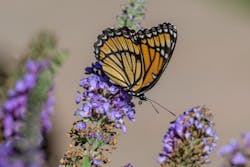The National Resources Conservation Service reports that 75% of the world’s flowering plants and approximately 35% of the world’s food crops depend on animal pollinators to reproduce. However, pollinator populations have reduced significantly in recent years and a loss of habitat is recognized as a primary cause. With utility right-of-way corridors providing an ideal environment for the development of native plant communities that support pollinator species, utility companies have an opportunity to embrace industry best practices that provide significant environmental benefits. Embracing recommended strategies can also appeal to the general public, as 69% of consumers in North America believe it is extremely important that companies implement programs to improve the environment, according to the Conference Board Global Consumer Confidence Survey.
Plants that improve habitat for pollinators are mostly compatible with the management of energy and transportation infrastructure, which is why the Rights-of-Way as Habitat Working Group (ROWHWG) developed the Pollinator Habitat Scorecard.
- Facilitates industry learning and collaboration by providing a common language regarding habitat on energy and transportation lands
- Establishes a consistent valuation method across rights-of-way sectors to align with existing habitat assessments and reporting practices
- Encourages monitoring improvements by providing a flexible multi-tiered approach
- Enhances the sharing of habitat metric reporting across all industries
Having worked with ROWHWG over the past six years, Iris Caldwell, program manager for Sustainable Landscapes with the Energy Resources Center at the University of Illinois-Chicago, emphasizes the importance of adapting practices that effectively support pollinators.
“Pollinators are the basic building blocks of our ecosystem,” Caldwell says. “When we see collapses in pollinator populations, it’s something we all need to be concerned about. A variety of vegetation management practices can support the creation of early successional habitat, and we can do so while ensuring compatibility with the needs of utility and transportation rights-of-way.”
The management practices Caldwell mentions include a combination of mechanical, chemical and biological control methods, each of which are part of an Integrated Vegetation Management (IVM) strategy. IVM practices featuring the use of selective herbicide applications have been proven to be the most environmentally friendly approach to controlling incompatible vegetation without disturbing native plant communities.
This past year, ROWHWG led a national multi-sector collaborative effort to create a voluntary conservation agreement for the development of monarch butterfly habitat. The Candidate Conservation Agreement with Assurances (CCAA) encourages landowners and land managers to adopt measures that result in net conservation benefits for monarch butterfly populations as the species has moved closer to extinction in recent years. As a supplement to the Monarch CCAA, the Pollinator Habitat Scorecard can be used to help participating organizations meet all monitoring requirements.
“The Pollinator Habitat Scorecard aligns with the monitoring and reporting requirements of the Monarch CCAA,” Caldwell says. “Organizations enrolled in the Monarch CCAA can use Tier 1 of the Scorecard to meet the minimum monitoring requirements. Tier 2 or 3 also can be used to collect additional pollinator habitat data and qualify for a supplemental measure as well.”
For a snapshot of habitat quality on the ground today, or to better understand how management practices may impact habitat quality moving forward, access the habitat assessment protocol and management module through the Pollinator Scorecard User’s Guide. As a funding partner of ROWHWG, Corteva Agriscience also encourages industry professionals interested in learning more about the environmental benefits of effective land management strategies to visit HabitatWithHerbicides.com.
™ Trademark of Corteva Agriscience and its affiliated companies.
Sponsored by:
